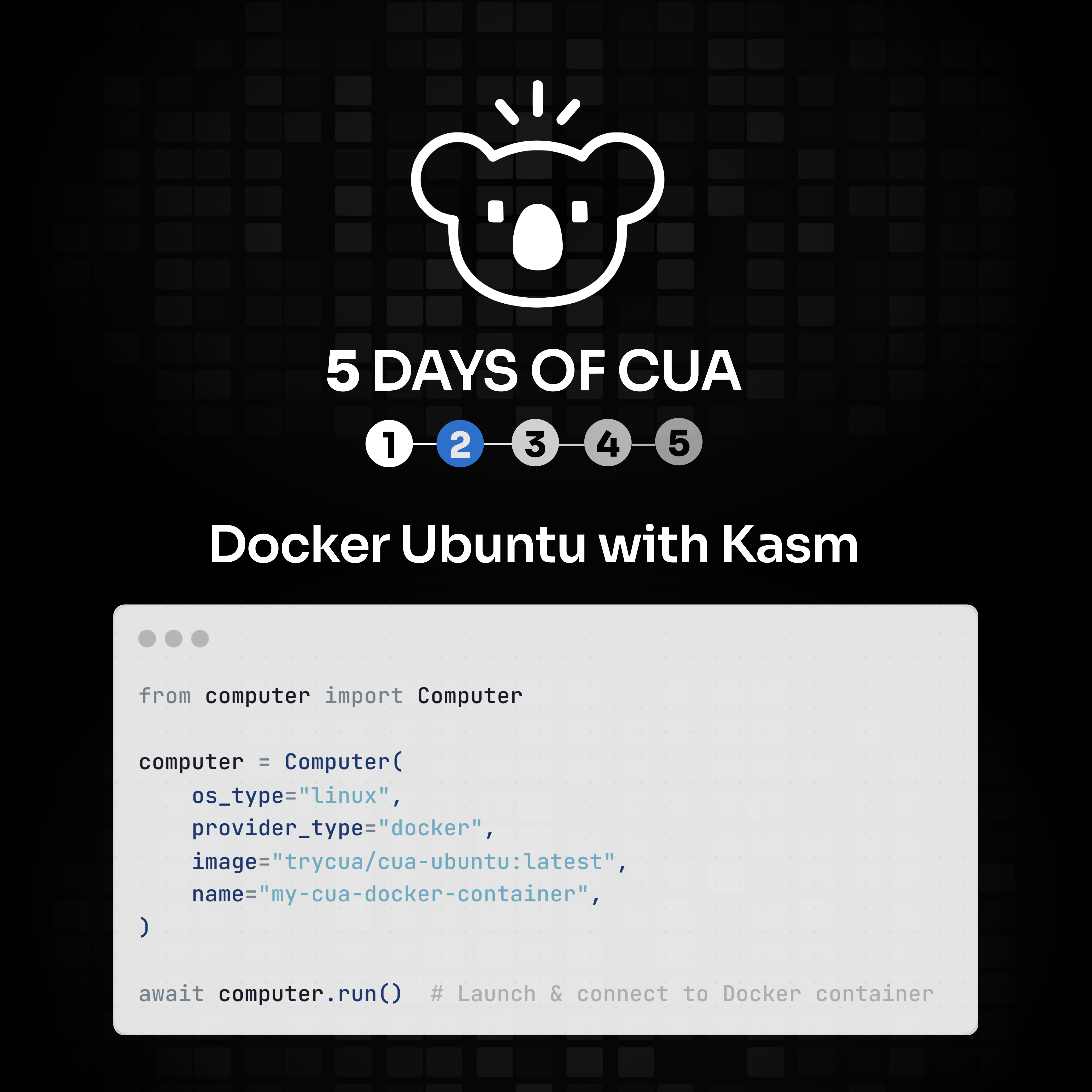Ubuntu Docker Support in Cua with Kasm
Published Aug 26, 2025 by Francesco Bonacci
Today we’re shipping Ubuntu Docker support in Cua. You get a full Linux desktop inside a Docker container, viewable right in your browser—no VM spin-up, no extra clients. It behaves the same on macOS, Windows, and Linux.

Why we did this
If you build automation or RL workflows with Cua, you’ve probably run into the usual platform walls: macOS VMs (via Lume) are Apple-Silicon only; Windows Sandbox needs Pro/Enterprise; giving agents your host desktop is… exciting, but risky; and little OS quirks make “build once, run anywhere” harder than it should be.
We wanted something lightweight, isolated, and identical across machines. So we put a desktop in a container.
Why we didn’t use QEMU/KVM
Short answer: portability, startup time, and ops friction.
- Runs everywhere, no hypervisor drama. KVM needs Linux; Hyper-V/Virtualization.Framework setups vary by host and policy. Docker is ubiquitous across macOS/Windows/Linux and allowed in most CI runners—so your GUI env actually runs where your team works.
- Faster boot & smaller footprints. Containers cold-start in seconds and images are GB-scale; VMs tend to be minutes and tens of GB. That matters for parallel agents, CI, and local iteration.
- Lower ops overhead. No nested virt, kernel modules, or privileged host tweaks that many orgs (and cloud runners) block. Pull → run → browser.
- Same image, everywhere. One Docker image gives you an identical desktop on every dev laptop and in CI.
- Web-first access out of the box. KasmVNC serves the desktop over HTTP—no extra VNC/RDP clients or SPICE config.
When we do reach for QEMU/KVM:
- You need true OS isolation or to run non-Linux guests.
- You want kernel-level features or device/GPU passthrough (VFIO).
- You’re optimizing for hardware realism over startup speed and density.
For this release, the goal was a cross-platform Linux desktop that feels instant and identical across local dev and CI. Containers + KasmVNC hit that sweet spot.
What we built
Under the hood it’s KasmVNC + Ubuntu 22.04 (Xfce) in Docker, pre-configured for computer-use automation. You get a proper GUI desktop served over HTTP (no VNC/RDP client), accessible from any modern browser. Cua’s Computer server boots automatically so your agents can connect immediately.
How it works (at a glance)
Your System
└─ Docker Container
└─ Xfce Desktop + KasmVNC → open in your browser
Quick start
-
Install Docker — Docker Desktop (macOS/Windows) or Docker Engine (Linux).
-
Pull or build the image
bash# Pull (recommended) docker pull --platform=linux/amd64 trycua/cua-ubuntu:latest # Or build locally cd libs/kasm docker build -t cua-ubuntu:latest .
- Run with Cua’s Computer SDK
pythonfrom computer import Computer computer = Computer( os_type="linux", provider_type="docker", image="trycua/cua-ubuntu:latest", name="my-automation-container" ) await computer.run()
Make an agent that drives this desktop
pythonfrom agent import ComputerAgent # assumes `computer` is the instance created above agent = ComputerAgent("openrouter/z-ai/glm-4.5v", tools=[computer]) async for _ in agent.run("Click on the search bar and type 'hello world'"): pass
Use any VLM with tool use; just make sure your OpenRouter creds are set.
By default you land on Ubuntu 22.04 + Xfce with a browser and desktop basics, the Computer server is running, the web viewer is available at http://localhost:8006, and common automation tools are preinstalled.
What’s inside (in plain English)
A tidy Linux desktop with web access through KasmVNC, Python 3.11 and dev tools, plus utilities you’ll actually use for automation—wmctrl for windows, xclip for clipboard, ffmpeg for media, screenshot helpers, and so on. It starts as a non-root kasm-user, lives in an isolated filesystem (unless you mount volumes), and ships with SSL off for local dev so you terminate TLS upstream when you deploy.
How it compares
| Feature | KasmVNC Docker | Lume (macOS VM) | Windows Sandbox |
|---|---|---|---|
| Platform support | macOS, Windows, Linux | macOS (Apple Silicon) | Windows Pro/Enterprise |
| Resource usage | Low (container) | Medium (full VM) | Medium (full VM) |
| Setup time | ~30s | 2–5 min | 1–2 min |
| GUI desktop | Linux | macOS | Windows |
| Web access | Browser (no client) | Typically VNC client | Typically RDP client |
| Consistency | Same everywhere | Hardware-dependent | OS-dependent |
Use KasmVNC Docker when… you want the same GUI env across devs/CI/platforms, you’re doing RL or end-to-end GUI tests, or you need many isolated desktops on one machine. Use alternatives when… you need native macOS (→ Lume) or native Windows (→ Windows Sandbox).
Using the Agent Framework (parallel example)
A compact pattern for running multiple desktops and agents side-by-side:
pythonimport asyncio from computer import Computer from agent import ComputerAgent # Create multiple computer instances (each gets its own desktop) computers = [] for i in range(3): c = Computer( os_type="linux", provider_type="docker", image="trycua/cua-ubuntu:latest", name=f"parallel-desktop-{i}" ) computers.append(c) await c.run() # Pair each desktop with a task tasks = [ "open github and search for 'trycua/cua'", "open a text editor and write 'hello world'", "open the browser and go to google.com", ] agents = [ ComputerAgent(model="openrouter/z-ai/glm-4.5v", tools=[c]) for c in computers ] async def run_agent(agent, task): async for _ in agent.run(task): pass await asyncio.gather(*[run_agent(a, t) for a, t in zip(agents, tasks)])
What’s next
We’re polishing a CLI to push/scale these containers on Cua Cloud, exploring GPU acceleration for in-container inference, and publishing prebuilt images for Playwright, Selenium, and friends.
Try it
pythonfrom computer import Computer computer = Computer(os_type="linux", provider_type="docker", image="trycua/cua-ubuntu:latest") await computer.run()
Links
- Docker Provider Docs: https://docs.trycua.com/computers/docker
- KasmVNC: https://github.com/kasmtech/KasmVNC
- Container Source: https://github.com/trycua/cua/tree/main/libs/kasm
- Computer SDK: https://docs.trycua.com/docs/computer-sdk/computers
- Discord: https://discord.com/invite/mVnXXpdE85
Questions or weird edge cases? Ping us on Discord—we’re curious to see what you build.